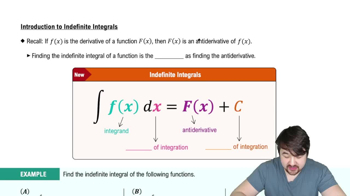Evaluate the indefinite integral as a power series: .
Table of contents
- 0. Functions7h 54m
- Introduction to Functions16m
- Piecewise Functions10m
- Properties of Functions9m
- Common Functions1h 8m
- Transformations5m
- Combining Functions27m
- Exponent rules32m
- Exponential Functions28m
- Logarithmic Functions24m
- Properties of Logarithms36m
- Exponential & Logarithmic Equations35m
- Introduction to Trigonometric Functions38m
- Graphs of Trigonometric Functions44m
- Trigonometric Identities47m
- Inverse Trigonometric Functions48m
- 1. Limits and Continuity2h 2m
- 2. Intro to Derivatives1h 33m
- 3. Techniques of Differentiation3h 18m
- 4. Applications of Derivatives2h 38m
- 5. Graphical Applications of Derivatives6h 2m
- 6. Derivatives of Inverse, Exponential, & Logarithmic Functions2h 37m
- 7. Antiderivatives & Indefinite Integrals1h 26m
- 8. Definite Integrals4h 44m
- 9. Graphical Applications of Integrals2h 27m
- 10. Physics Applications of Integrals 3h 16m
- 11. Integrals of Inverse, Exponential, & Logarithmic Functions2h 34m
- 12. Techniques of Integration7h 41m
- 13. Intro to Differential Equations2h 55m
- 14. Sequences & Series5h 36m
- 15. Power Series2h 19m
- 16. Parametric Equations & Polar Coordinates7h 58m
7. Antiderivatives & Indefinite Integrals
Indefinite Integrals
Problem 4.9.27
Textbook Question
23–68. Indefinite integrals Determine the following indefinite integrals. Check your work by differentiation.
∫ (5s + 3)² ds
 Verified step by step guidance
Verified step by step guidance1
Step 1: Recognize that the integral ∫ (5s + 3)² ds involves a polynomial raised to a power. To simplify, expand the square (5s + 3)² using the distributive property: (5s + 3)² = (5s)² + 2(5s)(3) + 3².
Step 2: Expand the terms: (5s)² = 25s², 2(5s)(3) = 30s, and 3² = 9. Combine these to rewrite the integrand as 25s² + 30s + 9.
Step 3: Break the integral into separate terms: ∫ (25s² + 30s + 9) ds = ∫ 25s² ds + ∫ 30s ds + ∫ 9 ds.
Step 4: Apply the power rule for integration to each term. For ∫ sⁿ ds, the rule is ∫ sⁿ ds = (sⁿ⁺¹)/(n+1) + C, where n ≠ -1. For constants, ∫ k ds = k * s + C.
Step 5: Combine the results of the integration for each term, ensuring to include the constant of integration (C). Finally, check your work by differentiating the result to verify it matches the original integrand.
 Verified video answer for a similar problem:
Verified video answer for a similar problem:This video solution was recommended by our tutors as helpful for the problem above
Video duration:
2mPlay a video:
Was this helpful?
Key Concepts
Here are the essential concepts you must grasp in order to answer the question correctly.
Indefinite Integrals
Indefinite integrals represent a family of functions whose derivative is the integrand. They are expressed without limits and include a constant of integration, typically denoted as 'C'. The process of finding an indefinite integral is often referred to as antiderivation, where we seek a function whose derivative matches the given function.
Recommended video:

Introduction to Indefinite Integrals
Integration Techniques
To solve integrals like ∫ (5s + 3)² ds, one may need to apply specific integration techniques. In this case, expanding the integrand before integrating can simplify the process. Techniques such as substitution or integration by parts may also be useful for more complex integrals, but recognizing when to apply these methods is key.
Recommended video:

Integration by Parts for Definite Integrals
Verification by Differentiation
After finding an indefinite integral, it is essential to verify the result by differentiation. This involves taking the derivative of the antiderivative obtained and checking if it equals the original integrand. This step ensures that the integration was performed correctly and reinforces the fundamental relationship between differentiation and integration.
Recommended video:

Finding Differentials

 5:04m
5:04mWatch next
Master Introduction to Indefinite Integrals with a bite sized video explanation from Patrick
Start learningRelated Videos
Related Practice
Multiple Choice
31
views
